| |
| |
| -- May 29th to June 9th 2012-- |
| |
|
How happy we are after 20 days at sea, to feel solid ground under our feet – and how beautiful the Azores are, a countryside heaven in the middle of the ocean.
More pictures between the bright green of the grass and the grey of the sky on our page "Pictures".
|
|

Sailed 134 miles
11 179 miles since the start
|
|
|
|
| |
|
May 29th -June 3rd 2012 : stop at Florès
|
|
|
At midnight, Saltimbanque is moored to a pontoon, standing flat and in silence: the happy and proud crew collapse in bed for a true night of sleep!
|
|
|
On the next morning we open the eyes on a green green world, a brand new landscape, charming, clean and welcoming. The surrounding cliffs explode of –green- colors under the sun. It’s like a wall of plants where high grass, dragon trees and (bonsai) palm trees can be found close to other European flowers. The village and its towering church are shining, with perfect clean white walls framed with the local black volcanic stones. A small street climbs up between stony houses with red or green window pans, each one with a tiny vegetable plantation stuck between the chicken-yard and the cliff.
|

View on the harbor
|
|
|
We can´t stand still, our legs are suddenly flying, so happy to be able to walk more than 3 steps in the same direction. We run along the jetties, along the pontoons, just to see whether the sea is the same on the other side of the harbor. More boats have arrived during the night, the marina is filling up quite quickly – everyone happy and relieved to be there before the upcoming storm.
|
|

Please direct all immigration-related questions to the green van
|
But before we can be set loose and wander around, reality calls us back: we need to carry out the formalities to check in to Portugal and the European Union. Flores is indeed the most western town of Europe! We start with the “GNR” (police), who fill in the paperwork on the hood of their car parked on the harbor. Then we visit the harbor office to log in by the marina and customs. The harbor master, Tiago, is probably just coming out of school. He is very friendly and does the paperwork while chatting about the weather, his island, and many other things. He tells us that 3 days before, there was only one boat in the marina. A few hours later we will count 24 sailing boats berthed there, 21 of them being largely more than 10m! Poor Tiago has to run everywhere and find solutions to fit everyone in! Last step to be fully official: the maritime police. The officer walks along the pontoons and everything is very easy. The same officer will even give us a lift a few days later!
|
|
|
Once officially entered in Europe, we start making ourselves comfortable. The weather is nice enough for the clothes and the boat to dry, we have fresh water at the tap, 220V onboard, high speed internet even inside, a flat boat: only missing the slippers to really feel home! And all this for only 10 euros a night. The only weak point is the harbor shower, in the fishermen house: very clean and so… but cold… Never mind we go for it, it´s not so terrible when you are sheltered from the wind!
|
|
The atmosphere in Flores is really nice. The harbor is so small that contacts are easy with the other sailors, everyone arriving coming from 3 weeks at sea and willing to talk! The first evening we invite the neighbors to share our bottle of Champagne, it was a very friendly evening. Even though bigger boats finally ended up here because of the storm coming, there are mostly small boats, and many single handed sailors, like our friend Richard from Sya who arrived a few hours after us.
The village is also very friendly! Fishermen say hello, and so do the car drivers passing by. At the town-hall we are welcome with a big smile, and given many maps of the island including a hiking guide of a hundred pages (for free… and dating back to 1993). On the day after they will lend us their scanner, everything is so simple… as life in a small village is, plus a very charming small village with small streets without cars and white and black houses in volcanic stones.
|

The new marina
|
|

Path down from the village to the harbor
|
You have to imagine Flores. A rock of 8km by 17, right in the middle of the Atlantic ocean. Except for its microscopic neighbor Corvo, the closest land is the island of Faial 300km in the south-east. New-York lies at 3000 km to the west, to the south there is nothing, to the north the violent oceanic low pressures. Well at least in the summer because in winter time they fly over the island creating gales and heavy rain falls every 5 days or so… According to Tiago, last winter people were running away from the higher dock area where 12m high waves were pushing the stored containers. On this improbable land, a small community of 3000 inhabitants lives out of farming and institutions (according to our taxi driver, more than half of the people are employed by the government). The cargo ship comes every 15 days with fresh products (some of them being directly reshipped to the even more isolated island of Corvo), and during the peak season a few sailors settle in for few days. There is hardly any other tourist. Life is very rural and we will see the killing and skinning of a big pork on the harbor!
|
|
|
We are very happy to have landed in Flores, it´s perfect to slowly get back into European life style. The harbor is very comfortable, perfectly sheltered from the winds from South to North by West. We realize this during our first real night at the pontoon: the foreseen gale arrived at 3 am, lots of rain, a wind reaching often 45 knots, and us comfortably lied flat under the blankets. Aaaah how well we are in the harbor… and we go back to sleep instantaneously!
|
|

Countryside around Lajes
|
|
|
After we slept as much as we could, caught-up on our internet business and bought a few fresh fruits and vegies, our batteries are now full enough to start discovering the island. Our first hike is rather short, towards “Faja de Lopo Vaz”, not far from Lajes (cautious with our soft muscles!) We begin with… going for lunch in a restaurant, enjoying a huuuge plate of local sausages, grilled chicken and fries of course, plus an ice cream, two beers and two coffees for just 10 euros p.p., also in prices are we far from the Antilles! Once fed, we cross the now familiar small town of Lajes, and get closer to the cliff. Here the path gets down to a “faja”, which means a flat piece of land tucked between cliffs – often an ancient lava flow. The panel at the beginning of the track promises us a tropical microclimate, we are a bit skeptical given the color of the sky and the humidity of the rain, but we keep going. Downhill it is indeed warmer by a few degrees and we walk along (small) banana trees and (green) pineapple plants. Very quickly we are back in the greasing fields, bordered with the typical little stony walls. Further down, a black sand beach on which huge waves break in snowy white foam…
|

Lopo Vaz, all the way down
|
|
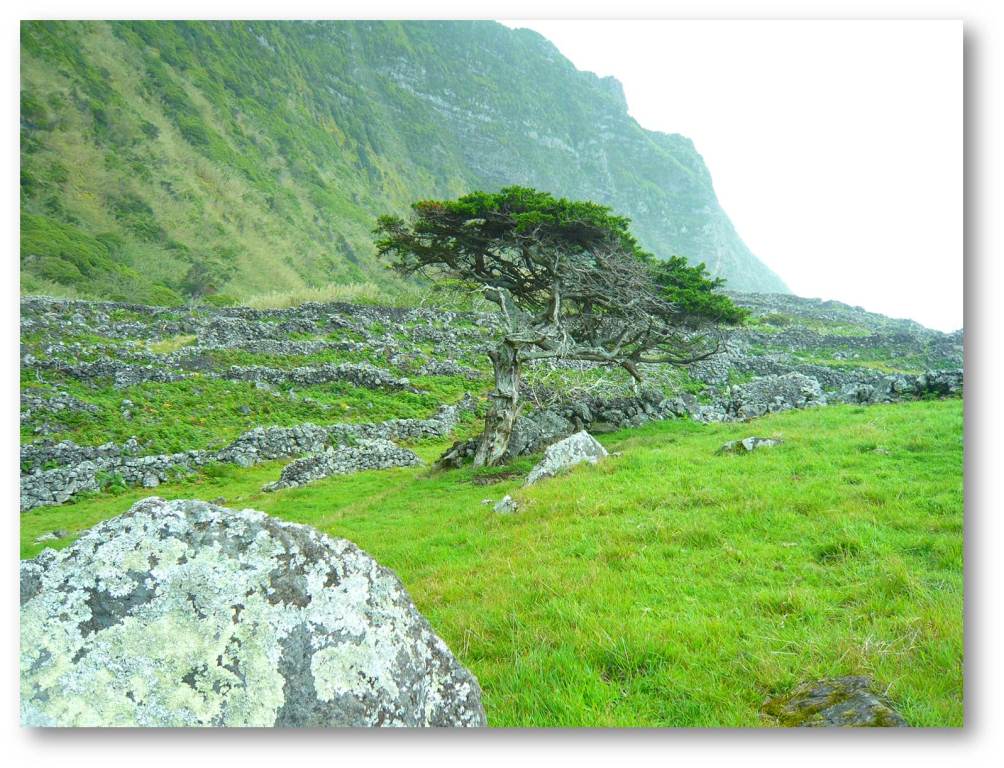
Fertile valley between the cliff and the sea
|
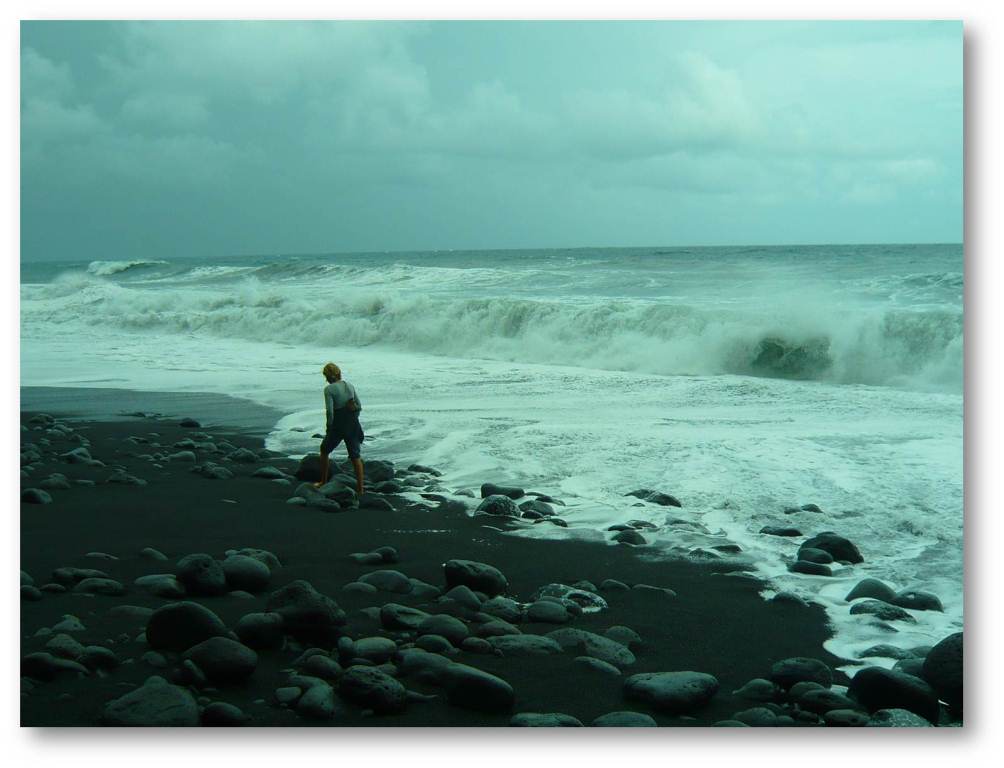
The picture has been taken in "color" mode…
|
|

Keeping the balance (copyright Sya)
|
Thus brought back into condition, the day after we leave for a longer hike with our friend Richard. A taxi drops us close to the lakes, a few hundred meter high summit. Inland the landscape is made of green hills covered by greasing fields and many lakes. It´s grey, cold and wet, but we are strangely happy to splash in the mud – sorry walk on the path! It´s just a very nice countryside, with green grass, thick moss, little European flowers, sheep and cows… A nice countryside as we can see everywhere in Europe. After 8 months on tropical lands burnt by the sun then washed away with intensive rains, and then 3 weeks at sea in the middle of the blue, we are very happy to be back in these familiar landscapes. We even transform physically into Europeans: losing our tan quickly - we are definitively going back home…
|
|

The lake region
|
|
|
After seeing several lakes, the path gets down quite steeply to the village of Faja Grande, very cute with its little green fields and the black lava shore beaten by the nice blue sea. We continue to the next valley, Fajazinha. From there we reach the “duck pond”, a magnificent lake surrounded by numerous water falls!
|
|

At the "Duck Pond", no palmiped but lots of waterfalls!
|

Your typical Azorian view on the way to Mosteiro
|
|
Then we keep climbing up to Mosteiro and its particular basaltic formation (Rocha dos Bordoes – or rock of the bees like a giant beehive). A few more kilometers to Lajedo at the south-westerly end of the island. It´s time to get back to Lajes: We hitchhike for the first time of the trip: it´s the most commonly used public transportation means on the island once the (only hence last) bus of the day is gone. The third car drives us to the top of Lajes, perfect !! We go down to the harbor via our favorite way, the “caminho do pescador” which slides down between nice houses and flowers…
We do feel well in Lajes, but the forecast shows a small weather window to sail for the island of Faial the day after, 130M to the South-East.
|
|
| |
| |
| TOP
|
| |
| |
|
June 4th 2012 : Lajès das Florès – Horta (134M)
|
|

Leaving Lajes
|
We are not the only ones to look at the weather forecast these days… On this morning, 9 of the 20 sailing boats of the marina are leaving Flores for Horta. The small boats leave at 9, the bigger ones around 11 – quickly overtaking the earlier in a few hours.
There is planned side winds, 20 knots, and we start with 2 reefs and 2/3 of the genoa. To our outmost surprise the other boats (not bigger than 10m) carry much more canvas. Well we are sailing almost as fast as the 9m boats but with one reef more, we are not going to deploy more sails!
|
|
|
The beginning is rather tough, quite a high swell from the side, 20 knots of wind, and the sky gets darker and darker… The wind starts picking up, we furl more genoa, and even take the 3rd reef. With our small hand size anemometer we measure 22-25 knots at the deck level, but the boats just nearby tell us they have 27 knots, with gusts up to 34 on their electronic wind meters. Well, we probably quite underestimate the wind in general! It´s not a bad thing as we don´t panic when the wind picks up, but we now understand why we always sound ridiculous at the bar afterwards when telling that we have to take the 3rd reef with 20 knots wind :oS
|
|
The squall goes away, the wind drops a bit and we can continue in quieter conditions. There is still a good wind abeam and Saltimbanque sails fast! The night falls in the middle of the navigation lights of our friends all around, no nap during the night shifts this time: we have to maintain an active watch under the moon light…
Finally the wind calms down at dawn and we are just 3 boats along the Southern coast of Faial. We take pictures of the other ones, hoping that one of them will have the good idea to do the same and that we can at last see how we look like under sails. Well we look like… very small!!
|

Saltimbanque sailing ahead of the wind, caught back by the bigger Zao before reaching Faial
|
|
|
In Horta, it´s really crowded… Several boats are anchored, by 10m water on a rocky ground of bad holding, for 6 euros a night, not so interesting! The welcome quay is packed, 5-6 boats alongside one another. We add an extra layer to the millefeuille, soon welcomed by the “3 gouttes” who have been moored here for a week. Finally the harbor master finds a berth for us inside the northern dock. It´s good to have a small boat sometimes! And the other boats of the Flores squadron have all been impressed by our speed, indeed we sailed the distance in less than 24h, i.e. 5,7 knots average! Quite a record :o)
|
|

Arriving to Horta
|
|
| |
|
June 5th to 9th 2012 : Stop in Horta
|
|

Horta's quays are famous for their paintings
|
Horta… The worldwide famous “Café sport” at Peter´s, the jetties covered by the paintings done by all the visiting boats, Horta is sort of a myth for sailors. Of course at the peak season of Atlantic crossings it has a little “factory”-like feeling, as about 30 boats probably come and leave every day. But still it´s Horta, a most particular stamp in the high seas sailors´passports :o)
Before we get installed at Peter´s, we go for few groceries (how nice are Portuguese supermarkets where you can find everything cheap!), and gather our friends for the evening in side Saltimbanque. The 3Gouttes and the Ster-Vraz tell us about their crossing, the storm, their hikes etc. So strange to see them wearing trousers and thick jerseys when we only saw them with shorts before!
|
|
|
The day after is Traditions Day. Walking the quays we see the paintings of many boats that we have met, one day, somewhere, or that we have heard of. In between of these anonymous sailors from the whole world we find the signatures of Pen Duick, Tara, Sodebo… Saltimbanque has already come here, the painting Jerome and Celine had done is still there after 5 years, and we chose a spot quite close to continue the story. Many “artists” work everyday, sometimes photographed by the few non-sailing tourists (more foreigners come to the Azores sailing than flying!) Despite the huge number of boats in the marina, we feel like in family on this quay where all the stories converge.
|
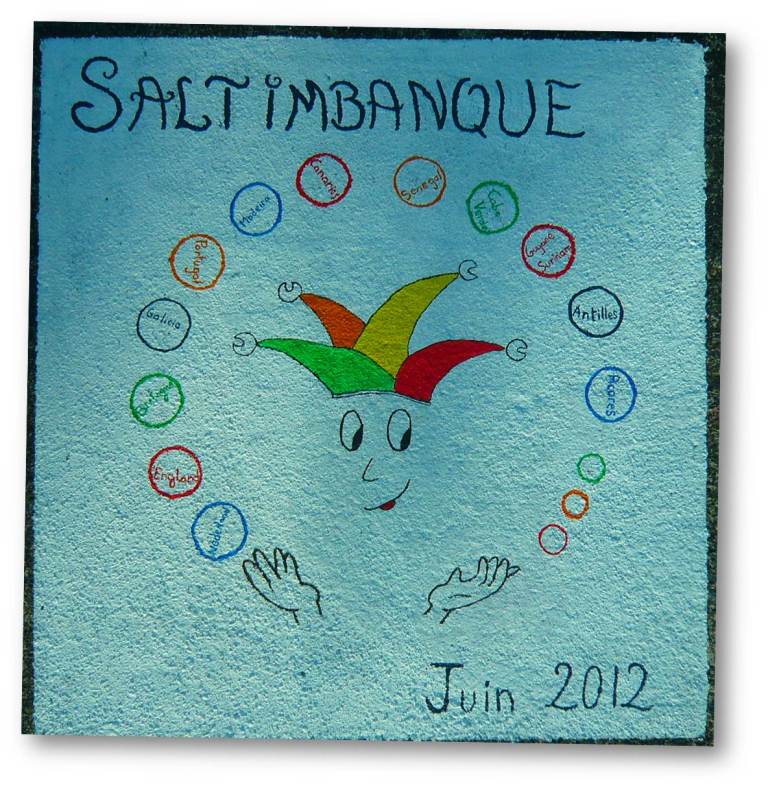
Here we go, we have a picture in Horta too!
|
|

Peter’s Café…
|
At night, our hands still covered by paint grab a beer at Peter´s. We have a drink with the crew of Zao, a nice looking old fashion boat that we met in Flores. Today more than ever we are part of the high seas family!
|
|
|
Our duty once accomplished we rent a car to discover the island (there is not handy bus). First stop: the Caldeira, the big crater on top of Faial, whose rim can be walked entirely in 2 hours, offering vertiginous views. Numerous shades of green come and go: the low heather, the deep pines, the bright grass. Here again food is to be found from the ground: nothing better than wild strawberries for dessert. In the crater fly the only species of day-time bats.
|
|

Looking at the crater from the trail
|
|
|
The road wanders away from the top, turning into a (very well maintained) dust track weaving amongst the meadows then into the woods – a happy mix of tropical (aloes, palm trees, fern trees…) and European (pines, plane trees…) plants. The flowers are blossoming: hydrangea next to daisies and butter cups, while at other places wild roses and lantanas mix with the blue agapanthus in the hedges. The names Faial (from “fayard” = beech ) and Horta (= garden) have not been chosen for no reason…
|
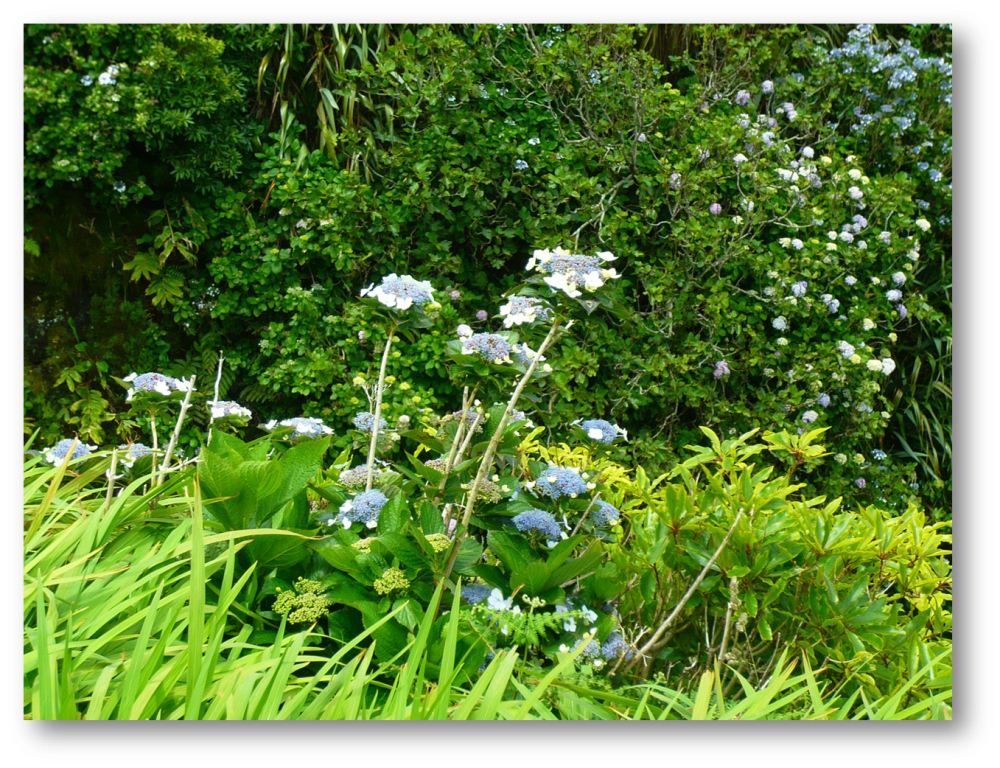
Faial is called "the blue island" because of its countless hydrangea hedges
|
|

Cautious, you'll enter in a new world in 200m
|
Driving along the wild and beautiful north coast we reach the western point of the island… which cropped up from the sea 50 years ago only! The Azores are torn between three tectonic plates: the American (Flores and Corvo), the European (the middle islands) and the African (Sao Miguel and Santa Maria). And so Flores is drifting away 2.5 cm/year from Faial. It took several millions of years to form the archipelago, and not one, but many volcanoes on every island. And this is not over… after a series of submarine eruptions in 1957/58 the Capelhinos Point in the west of Faial was born.
|
|
|
When you’re driving to this point, we see a lot of green – and then suddenly only dust and grey sand, just like on the moon. A lighthouse is still standing there, partially covered with ashes, pretty useless now that the sea is 1km further. Next to it, three round hills, 100 to 200m high, made of ashes and volcanic stones. An “Interpretation Center” has newly opened underground at the feet of the lighthouse. The visit is disappointed: lots of fancy 3D effects but little info repeated over and over (many times, as to justify the 10 eur entrance fee). But walking out on the little volcanoes themselves is really worth the while! It’s impressive to think that 50 years ago we would have stood on the water at this very spot…
|
|
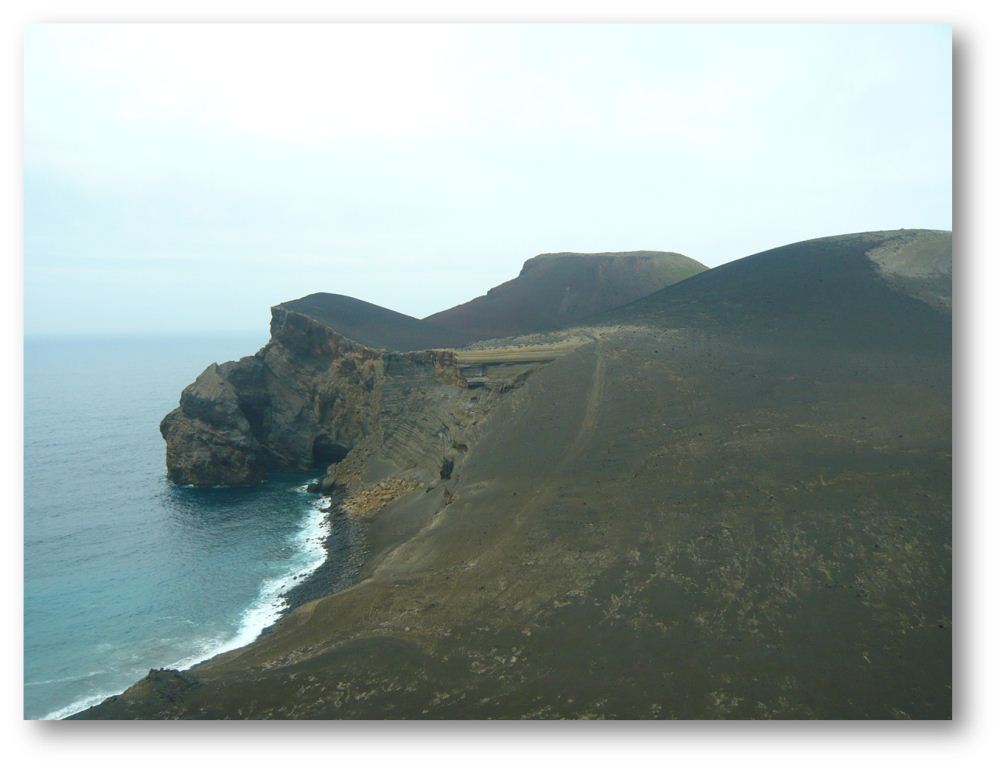
Capelinhos point, not more than 55 years old
|

Before the eruption in 1957, this lighthouse was standing on a cliff next to the sea
|
|
|
We drive on. To get to Varadourou there is a nice big road and a dust track. We choose… the dust track: very pretty little houses buried under tons of green and flowers and former vineyards. This little “harbor” (not sheltered from anything really) is famous for its “natural swimmingpools”. Like in Madeira the rocky coast has no sand beach at all, therefore few bathing options. But a couple of stairs stuck in the rocks, a concrete path on the boulders and some blue paint, and here you go: there’s a nice swimming pool! The water is not so cold to be honest (18 – 19° probably, we’ve known worse in Brittany!), but the grey and windy weather has us enjoy this very clever construction from the outside only.
|

"Natural swimmingpools" in Varadouro
|
|
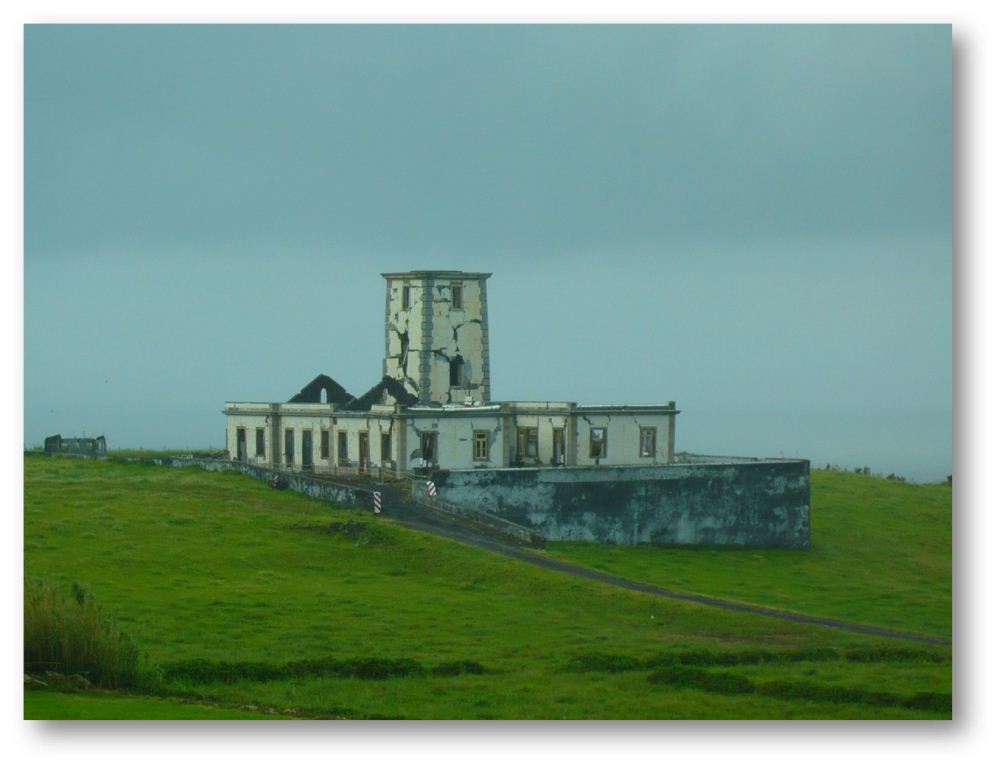
(What is left of) Riberinha Lighthouse – approaching the island by night on that side is not to advise.
|
Finally we stop in Riberinha in the north east of the island, where a big earthquake destroyed some churches and a lighthouse in 1998. In the village there is no one to be seen, it feels like a ghost town, some houses poorly repaired with hasty stitches where cracks on their walls were the bigger. The only happy sight is a newly painted shiny little “imperio” in front of the cracked church (the imperios are small buildings dedicated to the Holy Spirit, where an association stores the celebration gears and organizes a big party every year).
|
|
|
A wet and annoying drizzle is awaiting us in Horta – which has been lingering around all day long as we’re told, while we were walking in the sun. It’s all a matter of micro-climates here. We go and hide at Clube Naval, and enjoy diner with our Welsh pontoon neighbor from Flores, Tom (another single-handed sailor on a boat smaller than 10m :o) ).
|
|
|
On the next day we do lots of everything and little of anything in particular: some phone calls to start preparing the coming back to real life, some idle chats on the pontoons, some shopping… On the main square a big elegant building is home to the city museum. A nice collection of old postcards shows the evolution of the bay the construction of the breakwater in 1875 to date, from the old merchant sailing ships to the steamers and the American whaling boats, then the odd sight of the hydroplanes stopping to refuel, and finally the yachting frenzy. Another room displays a treasure of little white sculptures in… fig-tree kernels: the “marrow” of a fig-tree branch is, after drying, a good, light and bright white material for carving into hair-thin strains or minute blocks. Impressive! The boats and castles thus built weight about 100 times less than the beer we’ll handle a few hours later at Peter’s again, toasting with Richard to our paintings of the day and all our future sailing trips.
|

Horta Museum
|
|

Porto Pim and the little fishermen's houses
|
On Saturday the weather is not better… through the thick mist the jetty is barely visible. We spend some time working on the site in the warm and cosy cabin before daring a step outside. 10 minutes walk from the marina, the bay of Porto Pim is a testimony to the city’s fishing past. The bay itself is a former carter, thus perfectly round. Rows of quaint low houses and a little bar. The beach smells of seaweed, just like home – and is covered with dead “man-of-war” jellyfish not-at-all like home! They burst with a bang when we step on them :o)
|
|
|
The former whale processing plant is really worth a visit. Whaling has been a major resource for Faial from the 1850’s till the 1980’s, first thanks to the numerous American whaling boats stopping in the bay, then to local fishing and processing. The plant opened in 1943 and closed in 1973, processing a total of 1940 whales (sperm whales). Whaling has never been a matter of big boats with fancy equipment here: the whales were spotted by a lookout from the top of a hill and a small canoe was towed by a bigger motor-powered craft to the designed area. Then the canoe was left alone not to break the silence, chasing the beast with the oars and a small sail. The men first harpooned the whale, letting it pull the craft at crazy speed as it dive. When the whale was tired or needed to breathe, it would surface again. That was the most dangerous moment, when a man had to come close enough and stab it to the heart – until the canoe would capsize, the men drown, or the whale be killed. The dead animal was towed to the factory yard to be dismembered and skinned. Oil was the main product, liquid gold to fuel the lamps of modern America. The rest, meat and bones, was cooked and dried and crushed into animal feed and fertilizer.
|

A whaling boat brings a sperm whale back. Of course whaling is now over and forbidden in the Azores.
|
|
The other valuable product was the teeth. They were cleaned, brushed, sanded before being engraved by idle seamen or true artists. This art, called Scrimshaw, is explained at Peter’s Café – where we are heading to right now actually, to meet the Jingle (former Traou Mad) who just landed!
There would be no Horta without the beers shared between sailors. Yet it’s time for us to look further and find a wider horizon than this famous breakwater. Tomorrow we’ll be in Sao Jorge…
|
|
| |
| TOP
|
| |
| |
|
|
|
|
|
